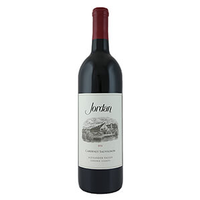Jordan, Alexander Valley (California) Cabernet Sauvignon 2014 ($55): Jordan Cabernet Sauvignon is one of California’s most consistent wines. With subtle changes from vintage to vintage, the wine typically shows a relatively restrained, graceful, food-friendly style, with fairly low-key fruitiness and the concentration and balance to develop beautifully for a decade or more. The 2014 vintage, the 39th release of Jordan Cabernet, is a lovely Cabernet that maintains that classic style.
for a decade or more. The 2014 vintage, the 39th release of Jordan Cabernet, is a lovely Cabernet that maintains that classic style.
What’s interesting to consider is how much has changed in the making of this wine over the years, without disrupting its trademark style. In terms of grape sourcing: The wine’s Alexander Valley appellation began with the inaugural vintage in 1976. The “estate-bottled” designation began in 1978 vintage, and continued until 1993, when replanting after phylloxera necessitated additional grape sourcing; replanting included new hillside sites on the estate. In 1996, the wine began carrying the appellation of Sonoma County, due to that replanting. Six years later, the wine regained its Alexander Valley appellation. In 2005, the winery began sourcing some Cabernet Sauvignon and Merlot grapes from top growers, as it continues to do. Soil-mapping of the estate vineyards in 2009 enabled precision farming. Last year, full circle, the winery began a seven-year project of replanting all the estate vineyards.
In terms of grape varieties: Cabernet Franc was introduced in the blend in 1987 and Petit Verdot was introduced in 2002. In 2005, Petit Verdot vines replaced Cabernet Franc as replanting of the estate continued. In 2006, Malbec was introduced in the blend.
In addition to this evolution of the raw material, winemaking changes have included increased emphasis on French oak and diminishing use of American oak since 2013, with the goal of using French oak exclusively. The route to consistency of style has hardly been a straight line!
The 2014 Jordan Cabernet Sauvignon is a blend of Cabernet Sauvignon at 79 percent, Merlot at 13.7 percent, Petit Verdot at 5.8 percent, Malbec at 1.2 percent and Cabernet Franc at 0.3 percent. Eighty-nine percent of the grapes come from Alexander Valley, with Mendocino County and Dry Creek Valley grapes accounting for 7 and 4 percent respectively. The wine aged in 94 percent French oak, 45 percent of which was new, and 6 percent American oak.
Here’s what to expect from the 2014 Cabernet: Deep aromas of dark fruits — blackberry, black cherry — mingle with subtle notes of vanilla, cedar and toasted oak. The wine is dry and full-bodied but lean, with plenty of dusty tannins that are very well integrated in the wine. Flavors of blackberry, cassis, dark plum and graphite are concentrated, and bring lovely balance between the wine’s flavors and its structure. The finish is long and it echoes the fruit concentration of the palate, promising a great future. Considering this wine in the context of elite California Cabernets, it is lighter in weight and texture than many a Napa Valley Cab, with more depth and more precision of its flavors, less power and more finesse.
Winemaker Rob Davis, who has been responsible for every Jordan Cabernet Sauvignon since that first vintage in 1976, likens this 2014 to a Pauillac, as opposed to a more typical comparison with St. Julien, because the wine’s tannins are broader and its structure is sturdier. Certainly, the 2014 has the tannin structure to develop over time. Remarkably, those tannins do not dominate the wine even at this early stage.
Drinkability when young (despite longevity potential) is one of the consistent characteristics of Jordan Cabernet Sauvignon and, together with its food-friendly balance, is probably one of the reasons that this wine is a favorite in restaurants. If you plan to drink it young, give it aeration: Rob Davis recommends 45 minutes.
92 Points
